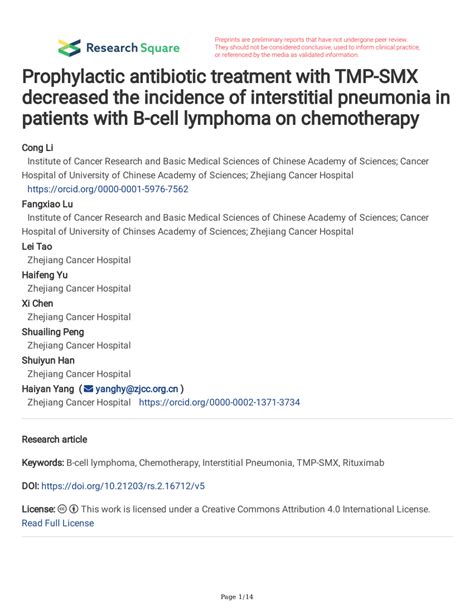The combination of trimethoprim and sulfamethoxazole, commonly referred to as TMP-SMX, is a widely used antibiotic for treating various bacterial infections. This synergistic combination of two antimicrobial agents has been a cornerstone in the treatment of several infectious diseases, including urinary tract infections, respiratory tract infections, and skin and soft tissue infections, among others. The effectiveness of TMP-SMX stems from its unique mechanism of action, which targets the bacterial synthesis of tetrahydrofolic acid, a critical component for bacterial DNA synthesis.
Historical Context and Development
The development of TMP-SMX dates back to the 1960s and 1970s, when the search for effective antimicrobial agents was at its peak. Trimethoprim, a dihydrofolate reductase inhibitor, was first introduced, but its use as a single agent had limitations due to the potential for resistance development. The combination with sulfamethoxazole, a sulfonamide that inhibits the synthesis of dihydrofolic acid, was found to enhance the antimicrobial spectrum and reduce the likelihood of resistance. This combination therapy was approved by the FDA in 1973 and has since become a staple in the treatment of various bacterial infections.
Mechanism of Action
TMP-SMX works by inhibiting the bacterial synthesis of tetrahydrofolic acid, which is essential for the production of purines, pyrimidines, and thus, DNA. Trimethoprim binds to and inhibits the enzyme dihydrofolate reductase, preventing the conversion of dihydrofolic acid to tetrahydrofolic acid. Sulfamethoxazole competes with para-aminobenzoic acid (PABA) for the enzyme dihydropteroate synthetase, necessary for the synthesis of dihydrofolic acid from PABA. This dual inhibition at two distinct steps in the folate synthesis pathway results in a potent bacteriostatic effect, making it difficult for bacteria to proliferate.
Clinical Applications
TMP-SMX is used to treat a wide range of bacterial infections, including: - Urinary Tract Infections (UTIs): TMP-SMX is often the first-line treatment for uncomplicated UTIs due to its efficacy against common urinary pathogens such as Escherichia coli, Klebsiella pneumoniae, and Proteus mirabilis. - Respiratory Tract Infections: It is used for the treatment of acute bronchitis, community-acquired pneumonia, and other respiratory infections caused by susceptible organisms. - Skin and Soft Tissue Infections: TMP-SMX is effective against Staphylococcus aureus and Streptococcus pyogenes, making it suitable for treating skin infections like impetigo, folliculitis, and cellulitis. - Prophylaxis: TMP-SMX is also used as prophylaxis against Pneumocystis jirovecii pneumonia in patients with HIV/AIDS and for the prevention of recurrent UTIs.
Resistance and Limitations
Despite its broad-spectrum activity, the use of TMP-SMX has been challenged by the emergence of resistance among certain bacterial strains. The overuse and misuse of antibiotics have accelerated the development of resistance, particularly in Escherichia coli, where resistance rates can be high in some regions. Moreover, TMP-SMX is not effective against all types of bacteria and has limited activity against Enterococcus species and Pseudomonas aeruginosa. Therefore, susceptibility testing is crucial to guide the appropriate use of TMP-SMX.
Side Effects and Precautions
While generally well-tolerated, TMP-SMX can cause side effects, including gastrointestinal disturbances, rash, and in rare cases, severe hypersensitivity reactions. It is also known to cause hyperkalemia, especially in patients with renal impairment. Patients with a history of sulfa allergy should be cautious, as cross-reactivity can occur. Additionally, TMP-SMX should be used with caution in patients with renal or hepatic dysfunction, as dosage adjustments may be necessary.
Dosage and Administration
The standard dosage of TMP-SMX for adults is one tablet (containing 160 mg of trimethoprim and 800 mg of sulfamethoxazole) taken orally every 12 hours for 10 to 14 days, depending on the type of infection being treated. Pediatric dosing is weight-based, and the duration of treatment may vary based on the clinical response and the specific infection being treated.
Conclusion
TMP-SMX remains a vital component of the antibiotic armamentarium, offering effective treatment for a variety of bacterial infections. Its broad-spectrum activity, coupled with its relatively low cost and oral administration, makes it a preferred choice for many clinicians. However, the rise of antibiotic resistance underscores the need for prudent use and the development of new antimicrobial strategies to combat evolving bacterial threats.
Key Takeaways
- TMP-SMX is a synergistic combination of trimethoprim and sulfamethoxazole used to treat various bacterial infections.
- Its mechanism of action involves the inhibition of bacterial tetrahydrofolic acid synthesis, essential for DNA production.
- It is effective against a range of bacterial infections, including UTIs, respiratory tract infections, and skin and soft tissue infections.
- Resistance to TMP-SMX is a growing concern, emphasizing the need for judicious antibiotic use and susceptibility testing.
What is the primary mechanism of action of TMP-SMX?
+The primary mechanism of action of TMP-SMX involves the inhibition of bacterial tetrahydrofolic acid synthesis, which is essential for the production of purines, pyrimidines, and thus, DNA. Trimethoprim inhibits dihydrofolate reductase, while sulfamethoxazole competes with para-aminobenzoic acid (PABA) for the enzyme dihydropteroate synthetase.
What are the common side effects of TMP-SMX?
+Common side effects of TMP-SMX include gastrointestinal disturbances, rash, and in rare cases, severe hypersensitivity reactions. It can also cause hyperkalemia, especially in patients with renal impairment.
Can TMP-SMX be used in patients with sulfa allergy?
+Patients with a history of sulfa allergy should use TMP-SMX with caution due to the potential for cross-reactivity. It is recommended to monitor these patients closely for signs of an allergic reaction.



